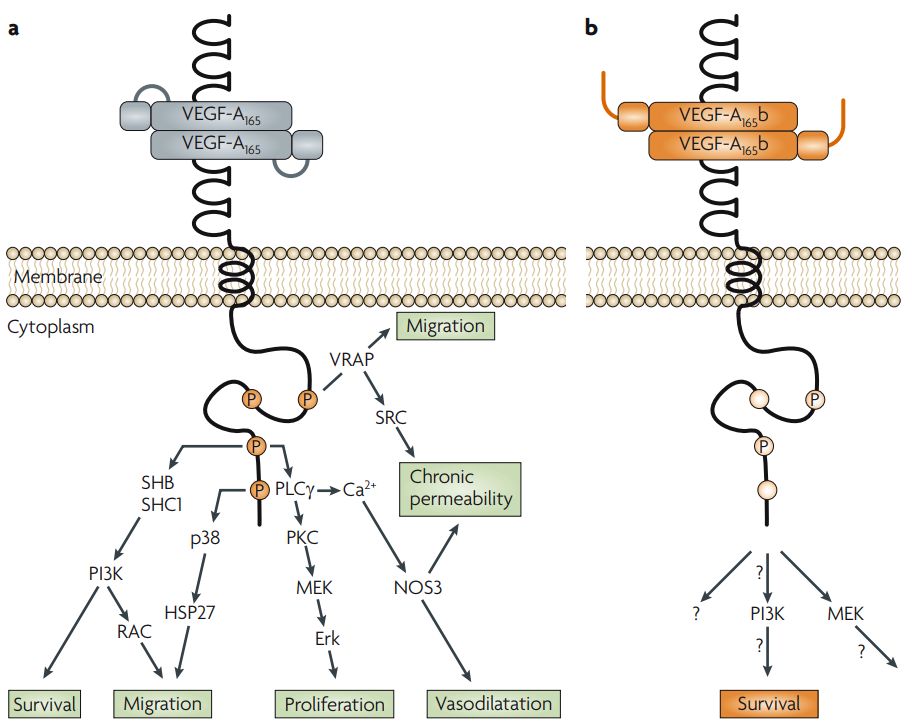What is VEGFA Protein
What is VEGFA Protein?
VEGFA, a member of the VEGF protein family, is a signaling protein crucial for angiogenesis—the formation of new blood vessels from existing ones. This protein exhibits a unique structural complexity, featuring multiple isoforms resulting from alternative splicing of the VEGFA gene. Among these isoforms are VEGFA121, VEGFA165, VEGFA189, VEGFA145, and VEGFA206, each with distinct properties and binding affinities for receptors.
The Structure of VEGFA Protein
The distinctive structure of VEGFA, marked by alternative splicing, contributes to its versatility in mediating diverse biological processes. For instance, VEGFA121 is known for its diffusibility, allowing it to influence regions with limited blood supply, while VEGFA165 plays a central role in angiogenesis. This structural diversity underscores the nuanced functionality of VEGFA in different physiological contexts.
The Function of VEGFA Protein
VEGFA's primary function lies in regulating angiogenesis—a critical process in embryonic development, tissue repair, and wound healing. Upon binding to specific receptors, notably VEGFR-1 and VEGFR-2 on endothelial cells, VEGFA initiates a cascade of events. These include endothelial cell proliferation, migration, and differentiation, as well as increased vessel permeability, facilitating the efficient delivery of nutrients and oxygen to tissues.
VEGFA-Related Diseases
The dysregulation of VEGFA is implicated in various diseases, with cancer being a prominent example. Tumors exploit VEGFA's angiogenic properties to establish a blood supply, supporting their growth and metastasis. Anti-angiogenic therapies, such as bevacizumab, strategically target VEGFA to disrupt tumor vascularization, representing a significant advancement in cancer treatment.
Beyond cancer, VEGFA is implicated in ocular disorders like age-related macular degeneration (AMD) and diabetic retinopathy. Abnormal blood vessel growth in these conditions leads to vision impairment. Inhibition of VEGFA has proven effective in managing these disorders, preserving vision and improving patient outcomes.
VEGFA Related Signaling Pathways
The signaling pathways activated by VEGFA are intricate, involving a network of molecular interactions that regulate endothelial cell behavior. VEGFR-1 and VEGFR-2 activation initiates phosphorylation cascades, influencing pathways such as Ras/MAPK, PI3K/Akt, and PLCγ. This complex interplay underscores the precision required in VEGFA signaling to maintain vascular homeostasis.

Figure 1. Signalling pathways downstream of vascular endothelial growth factor (VEGF-A)xxx and VEGF-Axxxb. (Harper, S., et al. 2008)
Applications of VEGFA in Biomedical Research
Cancer Therapy
- Anti-VEGFA therapies, including bevacizumab and aflibercept, have revolutionized cancer treatment by disrupting tumor vascularization.
- These therapies, often combined with traditional treatments, extend survival and improve outcomes in various cancers.
Ocular Disorders
- Intravitreal injections of anti-VEGFA agents like ranibizumab and aflibercept have become standard treatments for AMD and diabetic retinopathy.
- These interventions prevent abnormal blood vessel growth, preserving vision and enhancing patient quality of life.
Cardiovascular Therapeutics
- VEGFA's role extends to cardiovascular health, with researchers exploring its potential in cardiac regeneration post-myocardial infarction.
- Harnessing the regenerative properties of VEGFA presents new avenues for treating cardiovascular diseases.
Tissue Engineering
- VEGFA's angiogenic properties make it valuable in tissue engineering, enhancing vascularization in engineered tissues.
- Incorporating VEGFA into biomaterials holds promise for developing functional and viable organs for transplantation.
Neurological Disorders
- Ongoing research suggests a role for VEGFA in neuroprotection and neurogenesis, offering potential in nerve regeneration after neurological injuries.
- Exploring VEGFA's application in conditions like stroke and spinal cord injury presents exciting possibilities for neurological therapeutics.
The VEGFA protein emerges as a pivotal player in molecular biology, influencing angiogenesis and impacting a myriad of physiological and pathological processes. As we navigate the complexities of VEGFA signaling, the promise of innovative therapies and breakthroughs in medical science looms large, ushering in a new era of precision medicine and targeted interventions.
Recommended Products for VEGFA Protein
| Cat.# | Species | Product name | Source (Host) | Tag |
|---|---|---|---|---|
| VEGFA-210H | Human | Active Recombinant Human VEGFA | Insect Cell | N/A |
| Vegfa-38R | Human | Active Recombinant Rat Vegfa protein, His-tagged, 27-190aa, active | HEK293 | His |
| VEGFA-274H | Human | Active Recombinant Human VEGFA Protein, His-Avi-tagged, Biotinylated | HEK293 | His/Avi |
| VEGFA-210HAF488 | Human | Recombinant Human VEGFA Protein, None-tagged, Alexa Fluor 488 conjugated | Insect Cells | no tag |
| VEGFA-309HF | Human | Recombinant Human VEGFA Protein, FITC conjugated | HEK293 | 6 amino acids |
| Vegfa-18M | Mouse | Recombinant Mouse Vegfa protein | P.pastoris | N/A |
| Vegfa-878RAF488 | Rat | Recombinant Rat Vegfa Protein, None-tagged, Alexa Fluor 488 conjugated | Insect Cells | no tag |
| VEGFA-302CAF555 | Dog | Recombinant Canine VEGFA Protein, None-tagged, Alexa Fluor 555 conjugated | HEK293 | N/A |
| VEGFA-4326G | Goat | Recombinant Goat VEGFA Protein | Yeast | N/A |
| VEGFA-4373C | Chicken | Recombinant Chicken VEGFA Protein | Yeast | N/A |
Reference
- Harper, S., Bates, D. VEGF-A splicing: the key to anti-angiogenic therapeutics?. Nat Rev Cancer. 2008, 8: 880–887.

